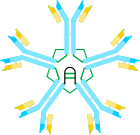| Cernunnos deficiency | |
|---|---|
| Other names | Combined immunodeficiency-microcephaly-growth retardation-sensitivity to ionizing radiation syndrome, Cernunnos XLFD |
 | |
| Cernunnos deficiency is inherited via autosomal recession | |
| Symptoms | Microcephaly |
| Causes | NHEJ1 gene mutation |
| Diagnostic method | Clinical features |
| Treatment | Immunoglobulin replacement, HSCT |
Cernunnos deficiency is a form of combined immunodeficiency characterized by microcephaly, due to mutations in the NHEJ1 gene, it is inherited via autosomal recessive manner Management for this condition is antiviral prophylaxis and antibiotic treatment.
Symptoms and signs
The sign and symptoms of this condition on an affected individual are as follows:
- Recurrent infections
- Microcephaly
- Growth retardation
- Bone-malformation
- Dysmorphic feature
- Urogenital malformations
Cause

In terms of genetics the condition, Cernunnos deficiency is due to a mutation in the NHEJ1 gene, it has a cytogenetic location of 2q35, while its molecular location is 219,075,324 to 219,160,865
Mechanism
The pathophysiology of Cernunnos deficiency begins with normal function of Non-homologous end-joining factor 1 gene. NHEJ1 encodes a protein which helps repair of breaks in double-stranded DNA. It might additionally act as a connection between XRCC4 and other NHEJ factors (at DNA ends)
When a mutation occurs in NHEJ1, then one sees that nucleotide deletions cause V(D)J recombination, signal joints, to be affected. V(D)J recombination is a genetic recombination that happens in early stages of B and T cell maturation.
Diagnosis

The diagnosis of Cernunnos deficiency will find the following in an affected individual via clinical features and blood test:
- B lymphopenia
- T lymphopenia
- Hypogammaglobulinemia with low IgA
- Hypogammaglobulinemia with low IgM
Differencial diagnosis
The DDx for Cernunnos deficiency are both LIG4 syndrome, as well as Nijmegen breakage syndrome
Management
In terms of management for Cernunnos deficiency, one finds that treatment with allogeneic hematopoietic stem cell transplantation, which are stem cells that bring about other cells) has proven useful in some instances. Additionally the following treatments are also used:
- Antibiotic treatment
- Immunoglobulin replacement
See also
References
- ^ RESERVED, INSERM US14 -- ALL RIGHTS. "Orphanet: Cernunnos XLF deficiency". www.orpha.net. Retrieved 2017-06-22.
{{cite web}}: CS1 maint: numeric names: authors list (link) - ^ "OMIM Entry - # 611291 - SEVERE COMBINED IMMUNODEFICIENCY WITH MICROCEPHALY, GROWTH RETARDATION, AND SENSITIVITY TO IONIZING RADIATION". omim.org. Retrieved 2017-06-22.
- ^ Reference, Genetics Home. "NHEJ1 gene". Genetics Home Reference. Retrieved 2017-06-22.
- "NHEJ1 non-homologous end joining factor 1 [Homo sapiens (human)] - Gene - NCBI". www.ncbi.nlm.nih.gov. Retrieved 2017-07-13.
- "OMIM Entry - * 611290 - NONHOMOLOGOUS END-JOINING FACTOR 1; NHEJ1". www.omim.org. Retrieved 2017-07-13.
- ^ Rezaei, Nima; Aghamohammadi, Asghar; Notarangelo, Luigi D. (2008-08-06). Primary Immunodeficiency Diseases: Definition, Diagnosis, and Management. Springer Science & Business Media. p. 56. ISBN 9783540789369.
- Roth, David B.; Antes, JR; Adams, RW; Trumm, GA (December 2014). V(D)J Recombination: Mechanism, Errors, and Fidelity. Vol. 2. pp. 313–324. doi:10.1128/microbiolspec.MDNA3-0041-2014. ISBN 9781555819200. ISSN 2165-0497. PMC 5089068. PMID 26104458.
{{cite book}}:|journal=ignored (help) - "Bone Marrow (Hematopoietic) Stem Cells | stemcells.nih.gov". stemcells.nih.gov. Archived from the original on 2021-05-15. Retrieved 2017-07-13.
- Sullivan, Kathleen E.; Stiehm, E. Richard (2014-08-08). Stiehm's Immune Deficiencies. Academic Press. p. 122. ISBN 9780124058606.
Further reading
- Ratcliffe, Michael (2016). Encyclopedia of Immunobiology (Vol 1 Development and phylogeny of the immune system ed.). Academic Press. ISBN 9780080921525. Retrieved 13 July 2017.
External links
| Classification | D |
|---|---|
| External resources |